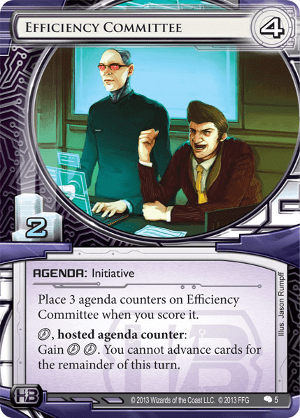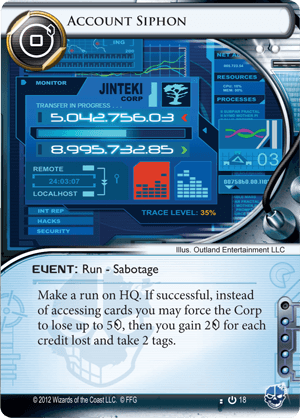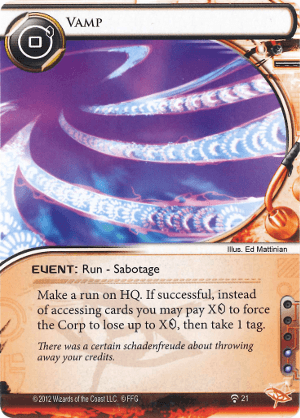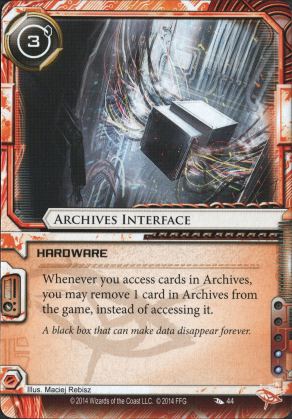Welcome back. In the previous article we talked about how to combo through all the various hate a CI7 has to deal with on their winning turn. In this article we are talking about setting up to get the combo. It should be clear that most combinations of combo-hate that a runner-deck brings can be beaten, so getting through the setup phase is the main way that CI7 loses the game.
X1 - X5 are some combination of: EC1, PV1, PV2, JH3 and EC2/PV3
For example (6 cards in hand, replacing both interns with SFK and RO(SFK) with SFSS. 11 credits.):
SFMM (JH, JH, JH) 1 **
PS 2 *
AD (BL, RO(AD), SFMM(PV1, PV2, GFI)) 9 **
AD (SFSS(PV1), SFSS(PV2), SFK(PV1/PV2)) 10 *
AD (SFSS(GFI), SFSS(GFI), SFK(GFI)) 11
score to win.
Setting up as CI7 is typically pretty simple, despite being the most skill intensive part of it. You have to draw cards until you have the combo - overdraw to trash any doubles (or play them outside of the combo turn), and generally have enough money to hold any of the cards you need. The skill in setting up comes from many things, such as knowing where to ice against who, what to mulligan against, and just gaining money and cards at the right times. Lastly there is also the factor of recognising whether or not you can combo early, and whether or not you can make any swaps to make it easier. In this, like all things, practice makes perfect, but here are some hints on things you can do.
Comboing through bad luck:
Because CI7 is a combo deck, it requires certain pieces to work. Inevitably, the pieces aren't going to fall into place as you expect. Some might chalk this to "bad luck", but it is actually very standard and you need to be able to take your own responsibility for winning through it. As such, not every problem related to setup is down to the runner having specific hate cards. Maybe the runner gets a lucky hit and trashes two Jackson Howards, or maybe all your Power Shutdowns are in the bottom 9 cards of the deck. Maybe they hit steal both your GFIs. Here are some hints at how to handle having less than the required number of cards to score out.
SFMM
Without SFMM in hand, you can replace it with an extra JH in hand and install it. This replaces the one that would be Interned from archives in the first pile. You can then replace that Interns with the SFMM you would usually play. As such, you need either 3 JH or 2 JH + EC (and 1 other installable) to combo without SFMM. You can also trade the RO(AD) slot if you have all 3 AD, and then you only require JH+EC (and 2 other installables).
For example (2 JH + JH/EC as well as one other installable):
PS 1 **
Install JH 1 *
AD (SFMM(JH, JH/EC, X1), RO(AD), BL) 8 **
AD (Interns(JH/EC), SFSS(EC), SFSS(EC)) 9 *
Score EC, take clicks 9 ****
AD (Interns(X2), SFSS(GFI), RO(SFK)) 11 ***
SFK(GFI/Vit) x3, score to win. 11
For example (3 AD, 1 JH + JH/EC and 2 other installables):
PS 1 **
Install JH 1 *
AD (SFMM(JH, X1, X2), Interns(JH/EC), BL) 7 **
AD (Interns(JH), SFSS(EC), SFSS(EC)) 8 *
Score EC, take clicks 8 ****
AD (SFSS(GFI), RO(SFK), spare) 10 ***
SFK(GFI/Vit) x3, score to win. 10.
Power Shutdown
This card is absolutely required to perform the combo. If you haven’t drawn it, there isn’t much you can do. One trick (not guaranteed to work) is to do some probability. You should be able to count the agendas in your hand, the number of cards in the deck, and how many of them left are agendas. If your deck is running low and you still haven’t drawn Power Shutdown, there is a reasonable chance that you can use a spare AD to look at the top 3 cards. If it is Power Shutdown, you can start the combo, and if it isn’t, then you just have to wait until next turn. This can be risky if you lose too many agendas, but may be better than the alternative if the runner is applying pressure. This obviously requires an extra AD than you would normally need to combo out.
Jackson Howard
At least 1 JH is absolutely mandatory to combo out. If you have the EC in hand you can use BL + AM to get one out, requiring 4 extra credits. If you have 1 JH but no EC, you can do a similar trick to SFMM, but with 3 AD, and you will still need 2 installables in hand. You can then replace RO(AD) with RO(JH) and do the SFMM trick to install the remaining ones.
For example, JH + 1 installable and 3 AD, requiring 11 credits:
PS 1 **
Install JH 1 *
AD (RO(JH), SFMM(JH, JH, X1), BL) 8 **
AD(Interns(EC), SFSS(EC), SFSS(EC)) 9 *
Score EC, take clicks 9 ****
AD (Interns(X2), SFSS(GFI), RO(SFK) 11 ***
SFK(GFI/Vit) x3, score to win. 11
For example, 1 installable + BL + AM but no JH, 3 AD, requires 15 credits (same as above but with BL + AM at first):
PS 1 **
BL 5 ***
AM (JH) 5 **
install JH 5 *
AD(RO(JH), SFMM(JH, JH, X1), BL) 12 **
AD(Interns(EC), SFSS(EC), SFSS(EC)) 13 *
Score EC, take clicks 13 ****
AD (Interns(X2), SFSS(GFI), RO(SFK)) 15 ***
SFK(GFI/Vit) x3, score to win. 15
Accelerated Diagnostics
AD is as important to the combo as JH and PS. You absolutely just have to draw it before you can start. The only thing that helps here is if there is one in Archives and you have an AM, then you can do the same as with JH by using AM to bring one back. Luckily there are 3 in the deck, so there is a high likelihood that you will draw at least 1.
Global Food Initiative
 |
| That evil runner, stopping you from feeding the poor |
If the runner happens to steal both your GFI, then you instead have to score 4 agendas.
For example (6 installables in hand, as well as 11 credits):
X1 - X5 are some combination of: EC1, PV1, PV2, JH3 and EC2/PV3
SFMM(JH, JH, X1) 1 **
PS 2 *
AD(BL, SFMM(X2, X3, X4), RO(AD)) 9 **
AD(interns(X5), SFSS(EC1), SFSS(EC1)) 10 *
score EC1 take clicks 10 ****
AD (SFSS(EC2/PV3), SFSS(EC2/PV3), RO(SFK)) 11 ***
score EC2/PV3 11 ***
SFK(PV1, PV2) x3. Score both to win. 11 ***
Efficiency Committee:
 |
| The inefficient way for the runner to stop you winning |
It is incredibly rare that the runner steals all 3 EC without already winning the game; however if they do so, it is not game over for you yet. You just need to generate extra clicks inside your combo to make up for not getting the EC clicks. Typically you just need to play 2 SFK and 1 SFSS more than the base combo requires.
For example (3 cards in hand but 2 BL and 2 SFK, replacing RO(SFK) with SFSS and using BL to play SFK from hand. 22 credits.):
BL 4 ****
BL 8 *****
SFMM JH JH JH 9 ****
PS 10 ***
AD (BL, RO(AD), interns(PV1)) 16 ****
AD (SFSS(PV1), SFSS(PV2), interns(PV2)) 17 ***
AD (SFSS(GFI), SFSS(GFI), interns(GFI)) 18 **
SFK(PV1, PV2) 22 *
SFK(GFI) 22
For example (6 cards in hand, replacing both interns with SFK and RO(SFK) with SFSS. 11 credits.):
SFMM (JH, JH, JH) 1 **
PS 2 *
AD (BL, RO(AD), SFMM(PV1, PV2, GFI)) 9 **
AD (SFSS(PV1), SFSS(PV2), SFK(PV1/PV2)) 10 *
AD (SFSS(GFI), SFSS(GFI), SFK(GFI)) 11
score to win.
Dealing with setup hate:
These are things that the runner does while you’re setting up that may stop you from being able to score out.
Trashing Jackson Howard:
JH is the only card in your deck with a trash cost, so even without any hate the runner can trash these and cause you problems. AM/RO or just drawing the remaining ones are your only hopes here once they are trashed; Typically hoping that they don’t access them is your early game strategy, as it is unlikely that they will. The newly released Rumor Mill also hoses your ability to play JH, however ELP into BL allows you to start the combo with this in play.
Trashing operations:
 |
| Stop! Hammer time! |
Via Imp, Keyhole, Edward Kim, or via milling such as Bhagat, Noise, etc.. Most of these you have multiple copies of and you only require 1. Just keep drawing, or again, use AM/RO if necessary. Against Imp, you should aim to purge immediately.
Forcing Draw:
 |
| Why yes Jackson, let me help you there. |
This has the potential to be one of the deadliest strategies against you, but only if the runner times it absolutely right. If the runner stops running, you need to get very low on your deck to combo out the next turn. If you let your deck get to 3 or less, then the runner can play Fisk Investment Seminar and you immediately lose the game, being unable to draw either then or the next turn when your turn begins. Alternatively, if you get to 4 cards, they can play Fisk Investment Seminar and then try and remove the last card from R&D via other means (running and hoping its an agenda/JH, or something like imp/keyhole/edward kim/Noise). You have several answers to this play. One is to leave a Jackson Howard on the board, having to draw one of the combo cards and play it instead (but saving a click from having to power shutdown). You can also use BL + AD + AD to clear up to 6 cards from your deck, allowing you the safety to prevent this from being an issue.
Econ denial:
  |
| Worst of all, people play these for the non-CI7 games too. |
Anything that makes you so poor that you have to discard cards. Vamp is the worst one here, and really your only answer to it is Reuse, or icing HQ sufficiently that they can’t get in (unlikely with your low ice count). Reuse is semi-reliable, but is risky since it greatly increases your agenda density in HQ. Account Siphon is also problematic if spammed until you are below the required credit threshold for comboing out. Getting rich fast is a good strategy against Account Siphon tech, although it may leave you vulnerable to having cards stuck in hand, anything other than SFSS can be played from hand, and extra money means you can use BL during your combo to play SFSS from hand too. Against Criminal early game, it may often be a good idea to not rez ice on HQ (assuming no other factors, such as Bhagat, Imp, Leela etc..). An access on HQ is often safer than letting them know which breaker to Special Order and get an Account Siphon off. If you suspect econ denial, it is definitely worth keeping Reuse in hand, as well as archived memories to reuse the Reuse. If you also keep both Biotic Labors in hand, a great strategy is to Reuse to a large number of credits, play Biotic Labor twice and start the combo as normal. Since Vamp/Siphon requires a run to trigger, you are guaranteed to be able to play power shutdown here. You can safely chuck a lot of spare cards without worrying about HQ density because you are winning on this turn.
Multi-access:
 |
| Eli1.0 - betraying us again! |
Medium digging, Keyhole, Legwork, TME, Indexing, etc.. All you can really do against these is ice up and purge, etc.. It is worth noting that you can’t use JH to prevent any of these effects (Indexing shuffle, lowering agenda density, etc..) as all the JH are fully required for the combo. Information Sifting is particularly bad here, but not a commonly played card (although CI7 prominence could change that). CBI raid doesn't necessarily do a lot unless you immediately keyhole after, as you can stack AD into BLC to draw the cards you need to combo and then immediately power shutdown after.
Employee Strike:
 |
| Apparently they don't like us altering their brain chemistry. Huh? |
Having to discard down to 5 cards is very problematic. Even the simplest base combo requires 6 cards in hand. It is worth noting that since you discard at the end of your turn, you may still be able to combo out here. A smart runner will not run after playing employee strike. Your best bets against Employee Strike are a) play ELP or b) Biotic out an agenda (assuming no Clot). The second option can still be quite debilitating, as it will cost you 7 credits which you may not be able to afford when it happens. ELP is also semi-problematic because it discourages the runner from running, when you may actually want them to do so in order to trigger Power Shutdown. These are obviously both better than just losing the game, however. Employee strike is only really a threat mid-late game, when you've drawn a large quantity of cards that you would have to discard. As such, you are more likely to have also drawn your counters to it.
‘Remove from the game’ effects:
 |
| Scary! |
Cards that remove Corp cards from the game will wreck you. If Archives Interface/Salsette Slums hit the right targets (JH, Interns, SFSSx2, RO), then it can be game over. Salsette Slums is only able to hit JH (and CVS) so your best bet is to hope they don’t hit it. Archives Interface is a bit worse; however, having certain combo cards removed can still be played around. If you have all 6 installables in hand then you don’t need Interns, and if you have 2+ AD in hand, then you only need 1 SFSS to score out. Similarly, if you have 2x AD in hand, then you can afford to lose another AD by recurring during the 2nd pile. You usually need 3x SFK, but these are often kept in hand and so are harder to trash with Archives Interface.
Preventing you from winning the game:
 |
| We have no answer to this. Lets hope it is played early. |
The only card that applies here is The Black File. This gives them three guaranteed turns where you can't win, and most CI7 decks do not pack any cards that counter this (a notable one being Foxfire). If The Black File comes out early, all you can do is wait for the 3 turns while they continue to access cards and pray that its not what they need to win. If The Black File comes out during the power turn (via a paid ability window like Street Peddler or Artist Colony) then it is game over, the runner has won. This card currently isn't a strong meta call, especially in decks that actually run Artist Colony and/or Street Peddler. It might just be that you have to accept that game as lost, or play fast enough that they can't get the right cards out to beat you.
Hidden information:
This has already been said in the second article, but Hidden information is important to work around. This also includes cards like Vamp, Siphon, Fisk Investment Seminar, Information Sifting that the runner can save in hand and use to wreck you during a power turn. Most of your protection against these cards is in preparation, so if you suspect them you need to do what you can against them, such as icing appropriately against the runner's current rig, or getting the right cards in hand to recover from their effects.
Mulligans
Your opening hand is often a good starting point for how well you can do in the game. The best starting hand has some econ and at least 1 cheap to res ice. If you suspect siphon this should go on HQ, otherwise R&D. One of the rarer pieces required to setup your combo is also nice, such as a power shutdown or an accelerated diagnostics. Like most games, this also depends on the runner. If you are playing against a Maxx deck, then you should suspect Siphon, Eater and Keyhole, and therefore Turing is probably going to be the best ice for you, even if it costs 4 to res. In many other examples the magnet/Vanilla are going to be better as hard gear-check ETR. Ichi 1.0 is mostly there to be taxing when the runner is going for multi-access, such as via an R&D medium dig.
Scoring Early
If you score an EC early, you can skip an entire pile from your combo. This is a great way to cover for lost redundancy from some CI7 hate. Scoring a PV/ABT early is less helpful, but can also save you a few slots (for example, replacing the Interns (PV) for a SFSS(GFI) and the RO(SFK) for SFK(GFI) gets you the score without having to have the EC clicks). Sometimes you get in a very strong position and the runner is refusing to run, perhaps building up for a multi-access turn that might be a problem for you. Sometimes it might be good to naked install an EC here, forcing them to run early or letting you use BL to score it out. Figuring out when it is a good idea to do this requires a lot of practice, however if the runner is ever being slow and durdling along, it is usually a good idea to risk an EC in order to speed them up to your game. Scoring an EC is also a great way to empty your hand of the SFSS that tend to build up there, instead of having to overdraw, you can spend your clicks gaining money.
If you have an EC scored early, there are multiple things you can do, such as:
1. Winning in one JH pile (SFSS(GFI), SFK(GFI, PV), SFK(GFI, PV)).
2. Drawing with JH instead of playing PS (BL, BL, take 3 clicks, SFMM(JH, JH, X1), Double-draw x 6 for 12 cards, play AD to start combo). See this comment for more info.
3. FA a card from hand using spare SFSS or SFK in hand (install PV, advance PV, take a click from EC, SFSS(PV))
If you have an EC scored early, there are multiple things you can do, such as:
1. Winning in one JH pile (SFSS(GFI), SFK(GFI, PV), SFK(GFI, PV)).
2. Drawing with JH instead of playing PS (BL, BL, take 3 clicks, SFMM(JH, JH, X1), Double-draw x 6 for 12 cards, play AD to start combo). See this comment for more info.
3. FA a card from hand using spare SFSS or SFK in hand (install PV, advance PV, take a click from EC, SFSS(PV))
Conclusion
Thanks for reading the article on setting up as CI7. The next article will be on how to run against CI7.

Thanks for sharing this awesome blog with us. It was really nice to read it. No doubt it was really informative. Looking forward to see more blogs from you.
ReplyDelete